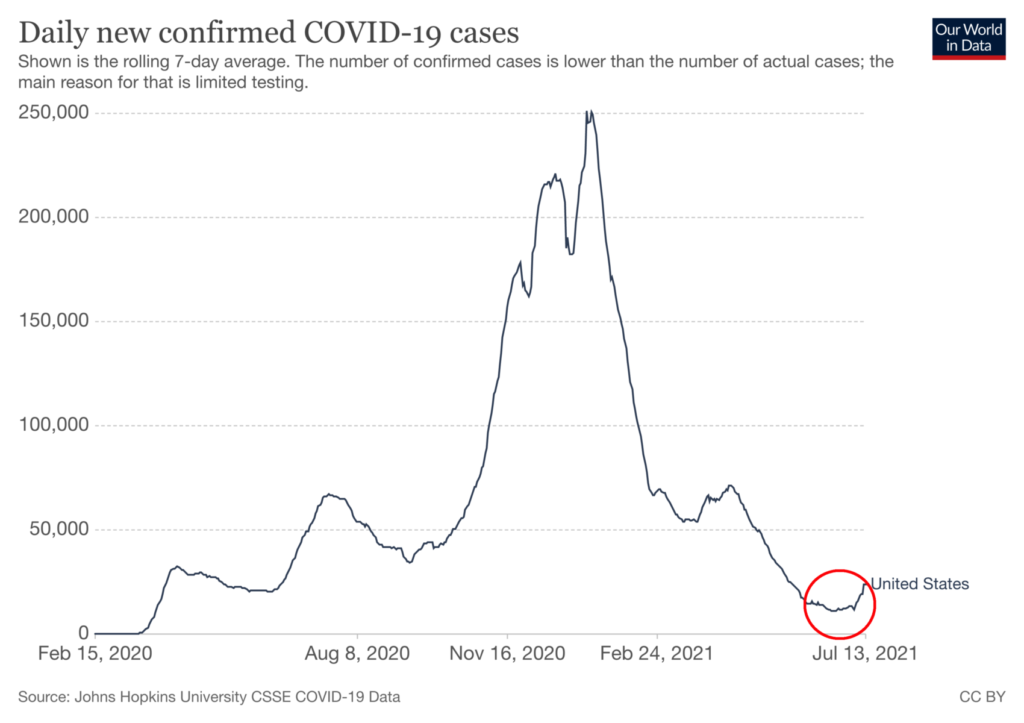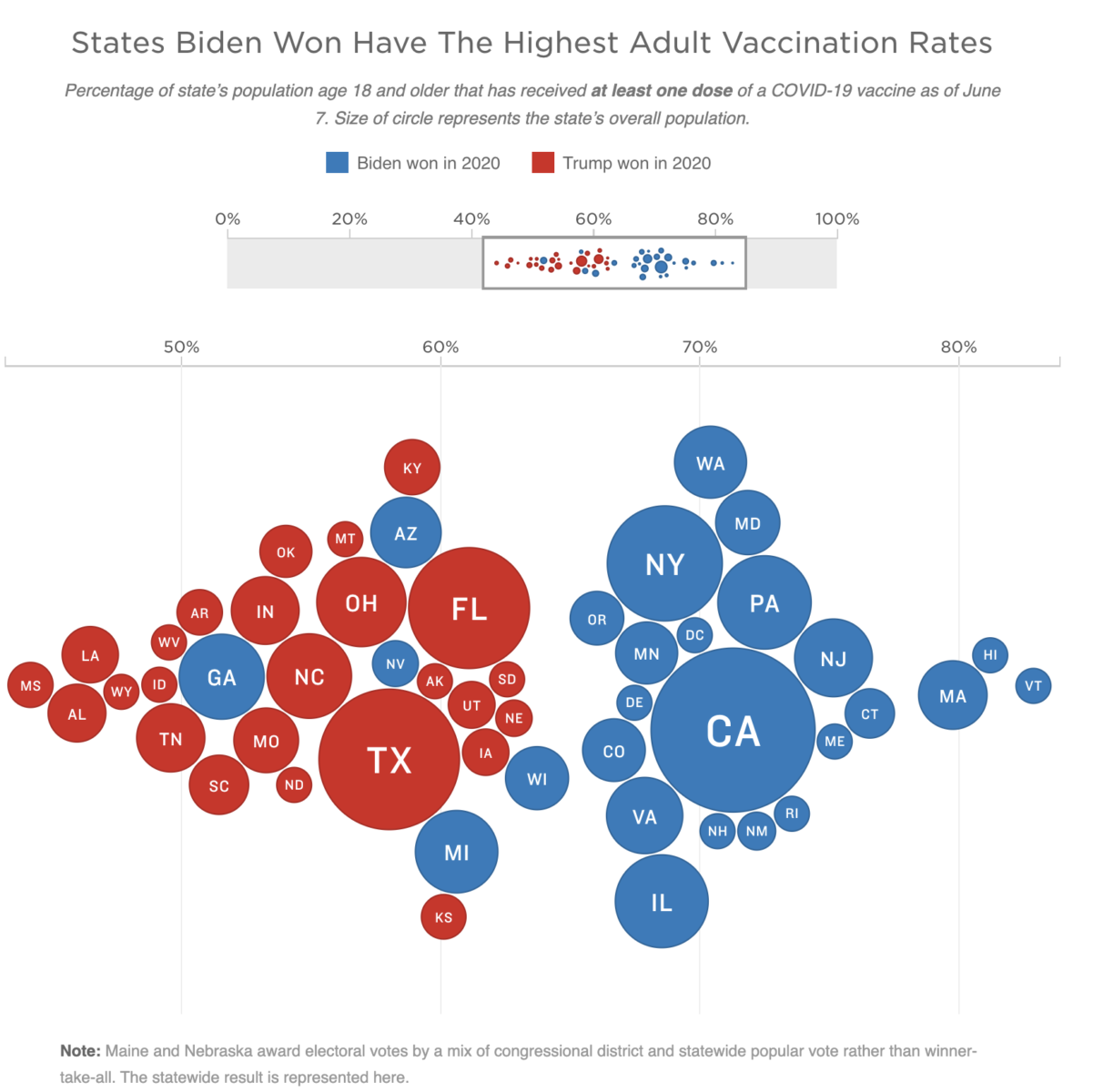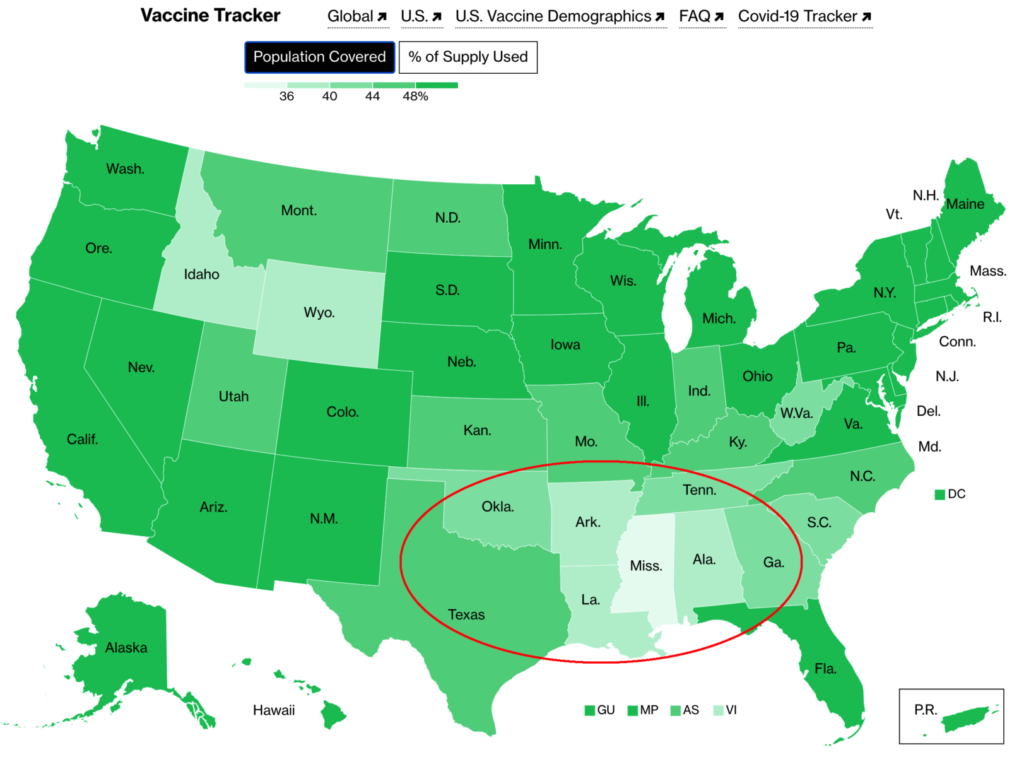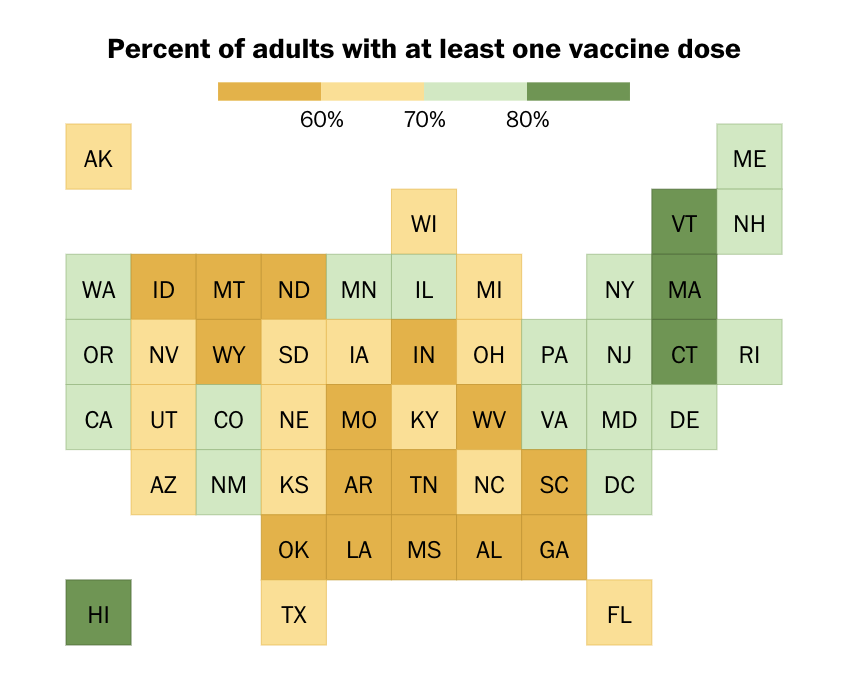Public perception of Covid risk is growing due to the Covid Delta variant and the impact of vaccine refusers.
This may begin to affect economic or market performance, foreshortening the recovery. JL
Barry Ritholtz reports in The Big Picture:
A solid case can be made for virus mutations as (an) economic threat. At the present pace, it will take 9 more months to cover the 75% of the population needed for herd immunity. So far, the Markets and the Economy are acting as if the pandemic is over. But these concerns raise the risk of an unanticipated economic contraction (and market effect) over the next 12-24 months. The risk is a two-track economic recovery: a robust recovery for the vaccinated, and a weaker recovery for unvaccinated regions selectively shutting down stores, restaurants and offices. Even without a lockdown, local economies might crash.
One of the favorite parts of my job is thinking about issues in ways other people often do not. That might include identifying where consensus may be wrong (Inflation, Urban Exodus, Insurrections) or market values responding differently than expected. Even for issues we fully understand, we can and do underestimate the impact on the economy, earnings and valuations.
These are not “Black Swans” as it is not the event’s occurrence that was unexpected or underestimated, but rather, the event’s consequences.
Framed differently:
Which is the larger economic threat, the Delta Variant or Inflation?
I am on record as seeing Inflation as a high probability event, but with low persistence and a transitory impact. The consensus around the results — earlier Fed tightening, more expensive credit/capital, end to the bull market — is a lower probability IMHO than many believe.
But a solid case can be made for virus mutations as the larger economic threat. The potential consequences of unchecked Covid-19 mutations on unvaccinated populations are very problematic, and consensus may have discounted this probability too much.
Let’s start with the good news:
A large proportion of the at-risk U.S. population has protected themselves (and their loved ones) from Covid by getting vaccinated. The new administration’s Vaccination roll-out has been a success, the economy is booming and the stock market is at all-time highs. The rapid vaccination ramp-up here has over 184.5 million people, and over 335 million doses given. The stock market has anticipated this for a long while, and the economy has been booming (hence those inflation fears).
But . . . as the below chart shows, that rapid adoption rate is plateauing. At the present pace, it will take at least 9 more months to cover the 75% of the population needed for herd immunity.
Which leads to the bad news. America is now fighting three simultaneous Covid related battles, and not doing well in any of them:
– Variants/Mutations are increasingly infectious/deadly;
– Vaccinations have become politicized;
– States and Counties with low Vaxx rates have higher infection rates.
So far, the Markets and the Economy are acting as if the pandemic is over. But these concerns raise the risk of an unanticipated economic slowing or even a contraction (and possible market effect) over the next 12-24 months. I put the possibility of this happening somewhere between 15-20%.
That is a fairly low probability, but those odds could tick higher if a number of things go wrong:
1. Delta Variant (and future Mutations): The Delta variant, also known as B. 1.617 was first identified in India. It is now the dominant strain here and accounts for 82% of all US infections.
We know it is a highly transmissible variant — much more so than the versions that were first identified in Q1 2020. Alpha variant was 50% more transmissible than the original coronavirus; Delta variant is 50% more contagious than Alpha — between 5-8 infections per carrier versus 1.8-2.5. Early data suggests it is more lethal also.
Transmission rates are exponential (you tell 2 friends, they tell 2 friends, etc.) so a small increase (they tell 5 friends, they tell 5 friends) can have huge repercussions. Some fear that a surge awaits us in the Fall, with prehaps the deadliest phase of the pandemic. Hence, why Delta has been called “Covid-19 on steroids.”
We are seeing the impact of the Delta variant in the uptick in infections — U.S. Covid-19 case counts have doubled recently — even as the total vaccination numbers have gone higher. (Do we really want to go back to full masks?) It is an arms race we were winning, at least until recently:
The biggest risk factor: unvaccinated individuals. They are the fastest-growing proportion of new cases in other countries.
~~~
2. Vaccinations have become politicized: The AntiVaxxers of the past few decades were founded on a debunked belief linking Vaccines and Autism.1
Thanks to Q-Anon, Fox News, OANN, NewsMax (and others), large swaths of the population now believe that Vaccines are problematic. What was once a bizarre and self-destructive movement has become during the pandemic a full-blown public health threat.
A third of White conservatives refuse to get vaccinated; Red southern states are shunning vaccines; it has now morphed into outright hostility, with politically motivated opposition to vaccine shots hardening. How that has played out has been reflected in each State’s vaccination rate, correlated to Presidential voting patterns:
There’s A Stark Red-Blue Divide When It Comes To States’ Vaccination Rates
Source: NPR
It’s even more pronounced on a County-wide level:
Least Vaccinated U.S. Counties Have Something in Common: Trump Voters
Source: New York Times
Note this is not just a USA problem, but Anti-Vaxxer propaganda is spreading in Asia, as well. The Unvaccinated are an increasing risk factor in the Netherlands and parts of Europe.
In the USA, we have a hypocrisy problem: Rupert Murdoch was vaccinated in December 2020 — but he never promoted that on Fox News. (Are any news hosts who rail against the Covid jabs not fully vaccinated?) Donald Trump got his vaccination in January 2021 — why not exhort the country to get fully vaxxed? The vaccines are arguably the biggest success story of his administration — why not promote it? What these folks have been saying about vaccines and what they did personally are polar opposites.
We were making very good progress towards herd immunity — until a hyper-politicized cross-section of the country decided they were against vaccinations. Consider what madness it is to “own” your political opponents by risking your health and life, and that of your family.
~~~
3. Regions with lower Vaxx rates have higher infection rates: The variants are pummeling unvaccinated people. The numbers are pretty staggering: Unvaccinated people now account for 99.7% of new coronavirus cases in the United States. The lower your state’s vax rate, the higher your infection rates are.
Unvaccinated hospitalized patients regret not getting the shot. At least, those that live do; consider that all Marylanders who died of covid in June were unvaccinated. And patients are now skewing younger. The CDC chief calls this latest uptick in infections as “the pandemic of the unvaccinated.”
As the map below shows, an 8 state-run stretching from Georgia to part of Texas are among the lowest vaccination rates in the country. Throw in Idaho and Wyoming to round out the bottom 10; add to those this uniquely self-destructive policy in Tennessee.
But a state-by-state analysis can be misleading — some states have a wide dispersion by county. California and Florida (as examples) have pockets of very high and very low vaccination rates. Those low vax counties present a risk of becoming Delta variant, ‘hyperlocal outbreaks‘ among the unvaccinated.
The vaccinated seem to be highly protected from the Delta variant, while the unvaccinated remain at risk. This is why health care workers are often required to get shots; other organizations are considering making it mandatory (not Idaho).
Even worse, every unvaccinated person is a chance for the virus to mutate again. The unvaccinated are “variant factories.” They do more than risk their own health and safety — they put the lives of everyone in the community at greater risk.
~~~
But this is a blog about markets and economics, not infectious diseases or booster shots. The risk here is we create a two-track economic recovery: A robust recovery for the vaccinated, and a weaker economic recovery for unvaccinated regions. This divergence will deepen the economic divide between regions, states, even countries. What happens when these regions are lagging further behind their neighbors?
The risk here is not a new mask mandate, but regions selectively shutting down stores, restaurants, offices, and local businesses. Worse, once people in a local high infection area come to realize what has happened, they will engage in a self-imposed “Shelter at Home.” The risk here is that even without a quarantine or lockdown, local economies might crash, as people begin to panic.
Since 2000, we have been through 3 major economic crashes: The ending of the 1990’s boom/dot-com implosion, the Great Financial Crisis, and now Covid-19. We are so close to putting this pandemic behind us, it would be a shame after spending trillions if we manage to snatch defeat from the jaws of victory.2
The bottom line is that Covid is still with us, and is going to be forever, as pandemics never really end. If we do not get a handle on this, the repercussions will be serious — and expensive.
______
1. The modern Anti-Vaxxer movement of recent years traces its origins to a paper published in The Lancet in 1998 by (then
Dr.) Andrew Wakefield linking 12 children who developed autism soon after vaccine administration. We later learn that Wakefield was funded by litigants against vaccine manufacturers, a detail he failed to disclose.2. One last admission: When considering contrarian or outlier concepts, the probability of being wrong is high. Last year, I posited the idea that the Covid vaccines might lead to the end of the anti-Vaxxer movement. Not only has that proven incorrect, but it looks more like naive wishful thinking today than a likely outcome.

























0 comments:
Post a Comment